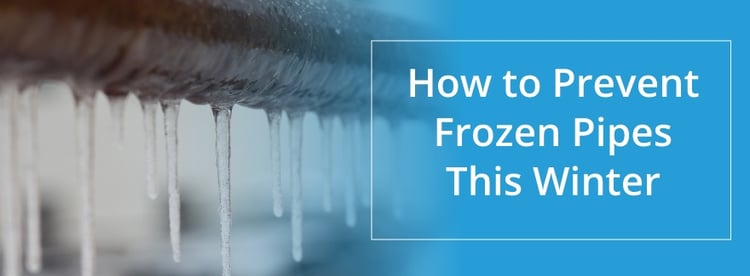
There’s nothing funny about frozen pipes. Cold weather can be bad enough, but having water pipes freeze is something no homeowner needs. Every winter, thousands of homes suffer from frozen pipes that cost thousands of dollars of damage per building. That’s a terrible loss, but the really sad thing is that almost all repair costs of frozen pipes are preventable.
According to the Insurance Institute for Business & Home Safety, the average damage cost from a ruptured frozen pipe is $5,000. That can go much higher when pressurized water uncontrollably pumps hundreds of gallons of cold water in your crawlspace or basement. All sorts of incidental damage happen like mold, mildew and rot. That’s not mentioning damage to goods stored down below.
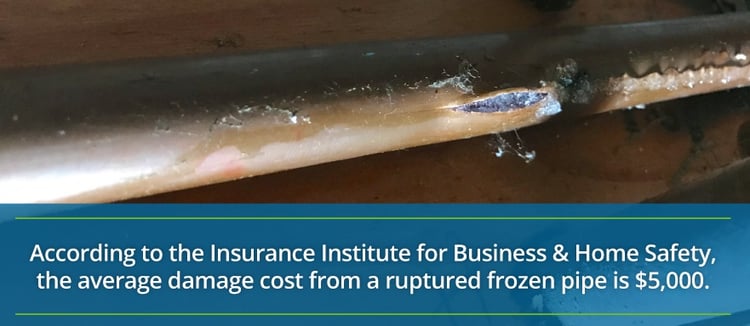
Preventing frozen pipes is simple, at least in theory. Only two things are required to make your pipes freeze. One is water present inside the pipelines. The other is temperatures falling below the freezing point. Remove either of these conditions, and you’ll never have dangers of frozen pipes.
But owning, maintaining and living in a home isn’t that simple. Water is a crucial element in providing a livable environment. Without water, there’s no life. Certainly no comfortable life, as you use water for so many tasks. Drinking and cooking are primary reasons you have water piped into your home. But you also use large volumes of water for bathing, cleaning the house, washing the car, watering the lawn and even filling the hot tub or pool.
Many homes also use hot water for heating as well as cold water for cooling down their habitat. All’s well as long as your water supply is contained and kept liquid. It’s when temperatures fall and water turns to solid ice that things begin to break down rapidly. The key to preventing frozen pipes is taking proactive steps. And part of prevention is understanding how water scientifically acts when your pipes begin to freeze.
What Happens as Pipes Freeze?
The first thing to realize about frozen pipes is you have two separate water systems in your home. Both are necessary to supply and discharge a continuous water stream, so you never run out and never run over. Having a water supply shortage is an inconvenience, but having a flood can be disastrous. Here’s how your two water control systems work:
- Pressurized Potable Water: This is called your supply system. If you’re in an urban area, you’ll likely have a metered line that’s under municipal pressure. Or you might be in a rural location and have well water pumped to your pressure tank. Then it’s distributed to tanks, taps and toilets. Most supply systems arrive at your house at around 120 pounds per square inch (psi). Pressure is then reduced by a specialized valve down to 65 psi.
- Passive Drain Water: This is your return water system. It’s also called drain, waste and vent or DWV. Wastewater comprises of gray water coming from your showers and black water from your sinks and toilets. It’s not under pressure. Rather, drain water depends on gravity to passively discharge it. If you’re in a city, then DWV water flows to a sanitary sewer system. If you’re rural, it’ll calmly run out to the septic tank and disposal field.
What have these two water systems got to do with potential freezing problems? Plenty. Both pressure and passive systems are equally vulnerable to freezing. But when a pressure line lets go, it spews far more water than a passive pipe ever could. Fortunately, each system is easy to prevent from freezing if you know the principles of water and how to work nature to your advantage.
Water is an amazing substance. Outside of being the basic building block of life, water has unique properties that nothing else has. Water is the only combination of molecules that expand both as a solid and a liquid but contract as a liquid. It’s the expansive force when liquid water turns solid that splits your pipes. We call that freezing.
Most people are taught that water freezes at +32 degrees Fahrenheit (0 Celsius). Technically, that’s correct. But in a household environment where liquid water is contained in a pressure or passive system, it doesn’t begin to ice until +20 Fahrenheit (-6 C). In building science, that’s called the optimum freezing threshold. Water stays liquid longer in a cold containment system from many factors. Pressurization is one. Pipe size and material is another.
Most people also think that pipes burst because liquid water expands into ice causing it to break or split. That’s only partly true. Knowing the real reason why pipes freeze and burst goes a long way towards preparing them for winter success. Here’s more frozen pipe trivia.
Why Frozen Pipes Burst
Frozen water can produce enormous pressure. Water isn’t like air that compresses when under pressure. There is no force in this world stopping water to expand as drops below the freezing threshold. Ice expands up to nine % by volumes and exerts between 25,000 and 114,000 psi, depending on the specific environment. Liquid water reaches maximum density at +40 F (+4 C). But when water changes its state to a solid, it actually expands and becomes lighter. This explains why icebergs float. It also explains why when you put a water bottle in the freezer, it bursts.
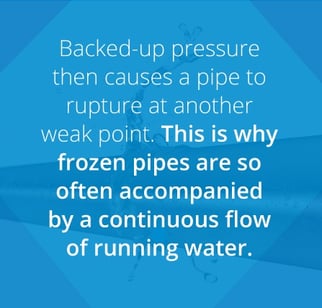 Now, you’d think it’s ice expansion that bursts water pipes. That’s true with passive DWV pipes that contain standing water. But it’s rarely the case with pressurized supply lines. Pressure actually allows water to freeze at a lower temperature. What happens is an ice plug forms at a vulnerable point in a supply line. Backed-up pressure then causes a pipe to rupture at another weak point. This is why frozen pipes are so often accompanied by a continuous flow of running water.
Now, you’d think it’s ice expansion that bursts water pipes. That’s true with passive DWV pipes that contain standing water. But it’s rarely the case with pressurized supply lines. Pressure actually allows water to freeze at a lower temperature. What happens is an ice plug forms at a vulnerable point in a supply line. Backed-up pressure then causes a pipe to rupture at another weak point. This is why frozen pipes are so often accompanied by a continuous flow of running water.
Running water is also harder to freeze than stagnant pools. You see this in winter when fast-moving streams stay open well past the icing stage. The same thing goes on in your pressurized lines — as long as they’re kept running. But stop the flow, increase the pressure, and you’ve got the ticket to trouble once your temperature passes the frosty threshold.
Don’t think just because your passive DWV water control system isn’t under pressure that it’s immune from bursting when frozen. Passive water takes a slightly different approach in forming to ice. Non-pressurized water forms hexagonal ice crystals that take up more space when reaching a solid state. They do this at a warmer temperature but exert two slightly different force patterns on the DWV pipes:
- Horizontal Force: Horizontal freezing force follows the pipe’s horizontal length. If a pipe length is long and not completely full, it’s very rare for a non-pressure plumbing pipe to rupture. That’s because there’s lots of room for expansion.
- Lateral Force: Lateral freezing force occurs across the pipe’s diameter or cross-section. Vulnerable points in passive lines are joints and bends that trap water and have little room to expand when frozen. This is why most passive pipe failures occur at elbow and P-traps.
Different Plumbing Pipe Types React Differently to Freezing
It’s worth mentioning that different types of plumbing pipes have different resistance to bursting when frozen. There are reasons why certain materials are used for different plumbing pipe application. Let’s quickly look at the standard types of pressure and passive pipes you’ll find in your home:
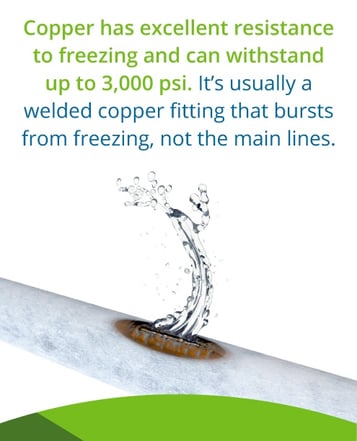 Copper Pressure Supply Lines: Copper was a mainstay in pressure lines for decades. It’s reliable and quiet, but the cost of entire copper systems makes it impractical today. Copper has excellent resistance to freezing and can withstand up to 3,000 psi. It’s usually a welded copper fitting that bursts from freezing, not the main lines.
Copper Pressure Supply Lines: Copper was a mainstay in pressure lines for decades. It’s reliable and quiet, but the cost of entire copper systems makes it impractical today. Copper has excellent resistance to freezing and can withstand up to 3,000 psi. It’s usually a welded copper fitting that bursts from freezing, not the main lines.- Plastic Pressure Supply Lines: You’ll see three colors used for plastic supply lines — black, gray and white. Black or polyethylene pipe is mostly used underground and enters your house up till the interior shut-off. It’s tough and durable. Gray pipes are polybutylene and have been phased out due to ultraviolet breakdown. White plastic supply lines are cross-linked polyethylene or PEX. You’ll normally see PEX lines in new construction or recent renovations. All plastic lines are strong and take withstand freezing to a point. Like copper, plastic lines usually fail when frozen at a connection.
- Plastic DWV Pipes: You’ll see two types of plastic drain pipes. The most common is black ABS pipe that’s welded together with yellow glue. The other is white PVC with blue or gray glued joints. ABS is used for interior work and is very resistant to bursts when frozen. PVC is outdoor material and breaks easily when standing water freezes.
- Cast Iron Pipes: Cast iron was commonly used until technology replaced it with cheaper and easier plastics. Cast is the most durable of all pipes. It’s exceedingly rare to hear of cast pipes failing from frost.
How to Prevent Pipes From Freezing
You have two foolproof ways of preventing your pipes from freezing this winter. One is removing all the water and letting them drain out. That includes pressure and passive plumbing lines. The other is not to let them get cold enough to freeze.
Unfortunately, that’s not always practical. Sometimes nature catches you off guard and brings on a cold spell before you’ve prepared. Sometimes you simply forget or overlook a vulnerable area. We’re human, after all.
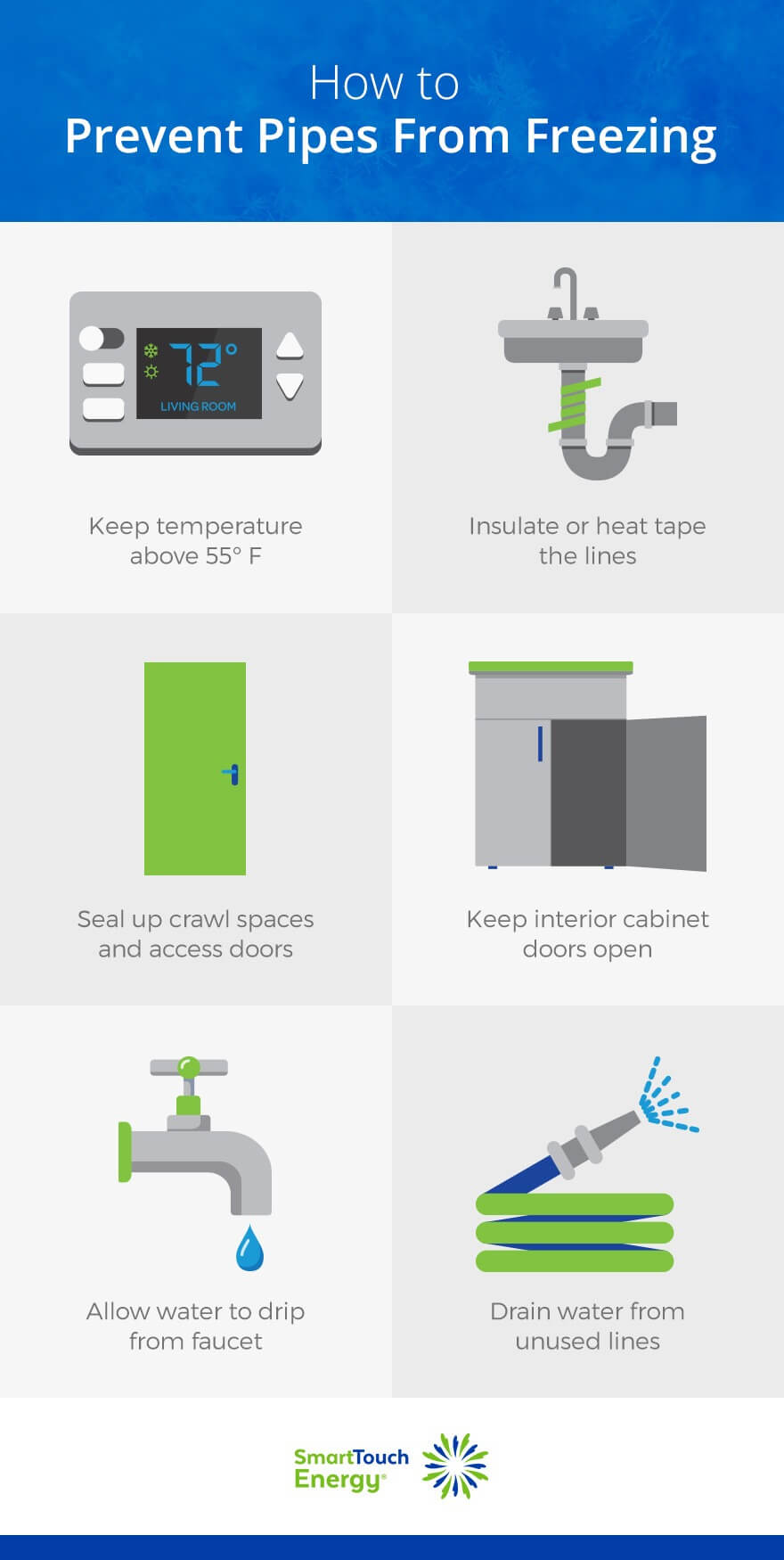
This work is licensed under a Creative Commons Attribution-NoDerivs 3.0 United States License. If you like our infographic, feel free to share it on your site as long as you include a link back to this post to credit Smart Touch Energy as the original creator of the graphic.
Prevention, being worth more per ounce than a cure, is the answer to making sure you never have frozen pipes again. And preparation for the cold season is the only way to ensure you’re safe. That’s winterizing for two conditions. One is heat-on buildings. The other is heat-off structures. Each has their own freezing prevention procedures.
Heat-On Winterization
The best method for preventing frozen pipes in homes heated during the winter is making sure the heat source never stops. That includes making sure the primary heat source is well maintained and always supplied with fuel. That might be an oil furnace system where the fuel tank is topped off on a regular, contract basis. The same goes with natural gas systems and electric baseboards.
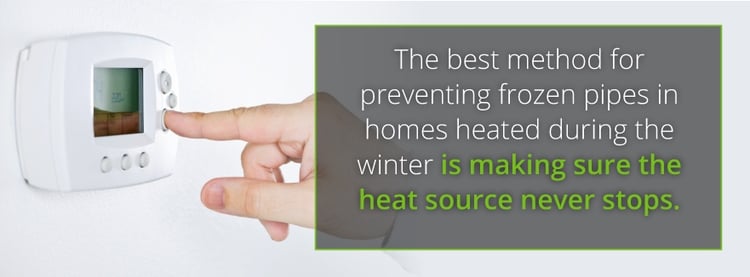
But you have to assume your heating system might temporarily fail or you have sudden cold periods that infiltrate your home’s perimeter. Here are suggestions for frost-proofing your heat-on winter pipes:
- Locate areas where drafts enter and block them. Moving air creates wind chill that significantly reduces static
- Crawlspace passive vents are routine offenders when left open during the winter. Close them and insert fiberglass batts or rigid foam.
- Insulate pipe runs. Use ready-made pipe sleeves and make sure there are no gaps.
- Consider using electric heating cables along long supply lines. They’re especially effective at vulnerable cold spots.
- Pat attention to perimeters. Most pipe freezing in heated homes occurs where pipes enter or exit the foundation and run along exterior walls.
- Watch for cold spots under plumbing fixtures. They’re called freeze-up points.
- Never turn your heat entirely off during cold weather. Once a freeze plug happens, the damage can start immediately.
- Disconnect outside water supplies. Unhook hoses, shut off the water from inside and drain the spigot. Make sure lawn irrigation and recreational water sources are off and dry.
- On really cold nights, don’t be afraid to let your interior water trickle. It’s especially effective for preventing freeze plugs.
Heat-Off Winterization
Buildings left unheated during the winter need special attention, as one of the dangers of turning off heat in a house is frozen pipes. Many people have vacation homes or recreational properties that get boarded up and left unattended over the cold season. Winter-proofing water supply and drain lines are critical steps in places left to the cold. The basic principle is to drain and dry if they’re not going to be heated.
Heat-off winterization starts with locating the main water supply and shutting off the valve. Make sure it’s the valve outside the building, not the secondary shut-off inside the crawlspace. Otherwise, that short section left full and exposed is guaranteed to freeze and rupture.
Outside shut-offs are usually located under the frost line and protected by earth. You may need a specialized tool called a curb-stop key to reach down and give the valve a half-turn. Once you’ve shut the water off, here are more steps to make sure you don’t suffer from frozen pipes:
- Open all your taps and relieve the pressure. That includes kitchens and bathrooms. Don’t overlook the toilets as standing water in the tank will freeze.
- Drain the hot water tank. Make sure the power source is disconnected, as a powered tank without water is dangerous.
- Like heated homes, disconnect and drain all outside water supplies.
- Pay attention to pressure tanks and sump pumps if you have them. Both should be drained and disconnected.
- Drain your P-traps. These are the elbows below sinks and in areas where gas back-venting is protected.
- Make sure your floor drains are clear. Standing water will freeze and create expensive damage.
- Do not depend on recreational vehicle antifreeze. It’s not dependable. And never use automotive antifreeze in any domestic system. It’s highly toxic and could be lethal.
Partner With a Reliable Home Heating Fuel Supplier
You don’t need to worry about frozen pipes if you’ve properly winterized your home. Your heat-off winterization will be just fine if you’re drained and dry. But even if you’ve done heat-on winterizing right, you’ll have a problem if you run out of heating fuel.
That’s especially true if your home is oil heated. That’s why you need to partner with a reliable home heating fuel supplier like Smart Touch Energy. We’ve been in the heating oil supply business for decades, serving many cold weather mid-Atlantic States.
We make delivering home heating oil so efficient with our Smart Touch Energy online ordering system. You simply enter your zip code, choose delivery options and place your order. It’s easy, quick and reliable. You also save money. Check oil prices online and purchase your heating oil today.





